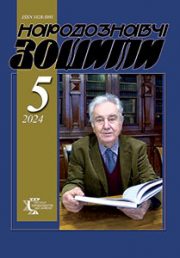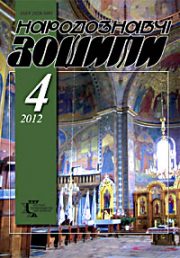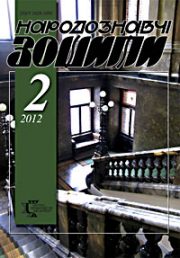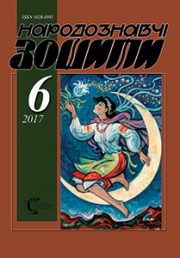The Ethnology Notebooks. 2025. № 3 (183), 559—565
UDK [75.02.03.046.3:27-526.62-144.5](477.83-25)”14/20″
DOI https://doi.org/10.15407/nz2025.03.559
THE IMAGE OF JESUS CHRIST IN OSTAP LOZYNSKY’S PROJECT «ANXIETY»: STYLISTIC FEATURES
SHEREMETA Borys
- ORCID ID: https://orcid.org/0000-0002-9060-3977
- PhD Candidate,
- Lviv National Academy of Arts,
- Department of Sacred Art
- 38, Kubiyovycha Str., 79011, Lviv, Ukraine,
- Contacts: e-mail: sheremetaborysart@gmail.com
Abstract. This article is devoted to the analysis of the work of Lviv iconographer Ostap Lozynsky, with particular focus on his project Anxiety, created in 2017. The article explores the background and key motivations behind the emergence of this project, highlighting the internal impulses that shaped the artist’s vision. The project carries a Passion-like character and resonates with Lozynsky’s earlier work, The Way (2014), allowing for a comparative study of both series on philosophical and artistic levels. The article emphasizes the continuity of reflection that connects these two cycles. Special attention is given to the further development and reinterpretation of Anxiety after the artist’s death, especially in the context of the brutal events following Russia’s full-scale invasion of Ukraine in 2022. The article also addresses the broader historical backdrop that influenced the artist and includes his own commentary on his creative process and on the state of contemporary Lviv iconography. The relevance of this study stems from the growing interest in the Lviv iconographic milieu of the early 21st century and its key figures, among whom Ostap Lozynsky occupies a significant place. At the same time, the importance of the chosen topic is reinforced by the ongoing war in Ukraine, which began in 2014. The purpose of the article is to examine the image of Jesus Christ in this project and to identify the stylistic features of its interpretation and embodiment. The primary research method is formal analysis, which enables a thorough investigation of the project’s linear, plastic, and color structure, wherein the artist masterfully intertwines visual language with a narrative rooted in war-related themes. The iconographic method is used to assess the degree to which the plastic qualities of the folk icon tradition (15th—19th centuries) influenced the project’s visual language. Additionally, the semiotic approach allows for an interpretation of the individual signs and symbols employed by the artist. The analysis reveals that Lozynsky sought to express a collective societal anxiety through the figure of Christ, while also addressing the image of Jesus as a deeply personal and existential motif through which the artist explored internal questions and experiences.
Keywords: Image of Christ, Ostap Lozynsky, Passion Cycle.
Received 22.05.2025
REFERENCES
- Sheremeta, B. (2024). Ideas and reasons for turning to the image of Jesus Christ in the Passion Cycle by Bohdan Soroka and Roman Zilinko. Drohobych Ivan Franko State Pedagogical University Journal, 75 (3), 126—133 [in Ukrainian].
- Sheremeta, B. (2024). Symbolism of the image of Christ in the Passion cycles of Olena Kulchytska, Osyp Sorokhtey, Ostap Lozynskyi. Visnyk Lviv National Academy of Arts, 52, 88—104 [in Ukrainian].
- Sheremeta, B. (2025). The image of Jesus Christ in the Passion Cycle of Julian Butsmanyuk: The Church of the Nativity of Christ in Zhovkva (1911—1939). Drohobych Ivan Franko State Pedagogical University Journal, 83 (3), 130—137 [in Ukrainian].
- Panas, V. (2017). Ostap Lozynskyi. ICONART Contemporary Sacred Art Gallery. Retrieved May 9, 2025, from https://iconart-gallery.com/uk/blog/165 [in Ukrainian].
- Lozynskyi, O. (2017). Anxiety, a sketch for a landscape. ICONART Contemporary Sacred Art Gallery. Retrieved May 9, 2025, from https://iconart-gallery.com/uk/exhibitions/by-id/145 [in Ukrainian].
- Barthes, R., & Zubrytska, M. (Ed.). (2002). The death of the author. In: M. Zubrytska. Anthology of world literary and critical thought of the 20th century. Litopys (Pp. 167—172) [in Ukrainian].
- Anxiety. Ostap Lozynskyi. (n. d.). Muzeum Archidiecezji War szawskiej. Retrieved May 9, 2025, from https://maw.art.pl/exhibition/trwoga-ostap-lozinski/ [in Polish].
- Barnett, Newman. The Stations of the Cross. Lema Sabachthani. (n. d.). Yale University Art Gallery. Retrieved May 9, 2025, from https://www.google.com/search?q=https://mavcor.yale.edu/conversations/object-narratives/barnett-newman-stations-cross-lema-sabachthani
- Rothko, Chapel. (n. d.). Retrieved May 9, 2025, from https://www.rothkochapel.org/.
- Werner, H. (1983). Picasso’s Guernica in historical context. Art & History, 7, 141—169.
- Adams, L. (2007). Art across time (3rd ed.). McGraw-Hill.
- Davydova, K.D. (2024). Pluralism of themes and images in the work of Yuriy Soloviy. Scientific Bulletin of Drohobych Ivan Franko State Pedagogical University, 76, 107 [in Ukrainian].
- Khomyshyn, M. (n. d.). Icon: To Know the Unknowable God, to Find Yourself. Retrieved May 9, 2025, from http://xic.com.ua/z-istoriji-dumky/3-bogoslovja/468-ikona-piznavaty-nepiznavanogo-boga-shchob-vidnajty-sebe [in Ukrainian].
- Otto Pankok 2005. (n. d.). Retrieved May 9, 2025, from https://artmap.com/museumkunstpalast/exhibition/otto-pankok-2005
- Stoian, S.S. (2022). Art and war: specificity of artistic transformations. Kyiv National Taras Shevchenko University Journal, 3, 121 [in Ukrainian].







